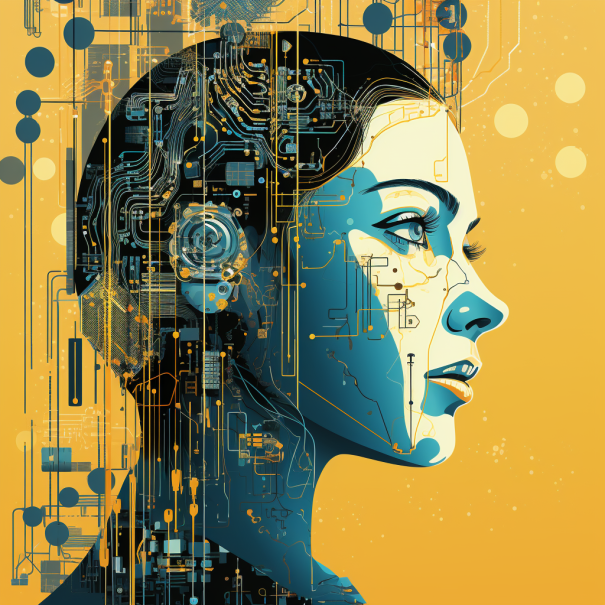Machine Learning & Artificial Intelligence: Shaping the Present and Envisioning the Future
This comprehensive blog post explores Machine Learning (ML) and Artificial Intelligence (AI), beginning with definitions and their interplay. It highlights their current applications across industries, major frameworks, and the ethical considerations surrounding AI. The post also envisions the future, focusing on deep learning advancements, AI in healthcare and autonomous systems, and the challenges and ethical concerns ahead. Additionally, it showcases how ML and AI are enhancing everyday life through virtual assistants, recommender systems, improved user experiences, and their role in cybersecurity and fraud detection.
9/4/20233 min read


Table of Contents:
Understanding Machine Learning and Artificial Intelligence
a. What is Machine Learning?
b. What is Artificial Intelligence?
c. The Interplay Between ML and AI
The Current State of Machine Learning and Artificial Intelligence
a. Applications Across Industries
b. Leading ML and AI Frameworks
c. Ethical and Regulatory Considerations
The Future of Machine Learning and Artificial Intelligence
a. Advancements in Deep Learning
b. AI in Healthcare and Medicine
c. AI in Autonomous Systems d. Challenges and Ethical Concerns
Machine Learning and Artificial Intelligence in Everyday Life
a. Virtual Assistants and Smart Devices
b. Recommender Systems
c. Enhanced User Experiences
d. Cybersecurity and Fraud Detection
Conclusion
1. Understanding Machine Learning and Artificial Intelligence
a. What is Machine Learning?
Machine Learning is a subset of Artificial Intelligence that focuses on the development of algorithms and statistical models. These algorithms enable computers to learn from and make predictions or decisions based on data without explicit programming.
b. What is Artificial Intelligence?
Artificial Intelligence, on the other hand, encompasses a broader scope, aiming to create machines that can perform tasks requiring human intelligence, such as understanding natural language, recognizing patterns, solving complex problems, and making autonomous decisions.
c. The Interplay Between ML and AI
Machine Learning is the driving force behind many AI applications. It empowers AI systems with the ability to learn and adapt, enabling them to perform intelligent tasks and improve their performance over time.
2. The Current State of Machine Learning and Artificial Intelligence
a. Applications Across Industries
ML and AI are being applied in diverse industries, including healthcare (diagnosis and drug discovery), finance (algorithmic trading and fraud detection), transportation (autonomous vehicles), and entertainment (content recommendation and game development).
b. Leading ML and AI Frameworks
Prominent ML and AI frameworks such as TensorFlow, PyTorch, and sci-kit-learn have democratized the development and deployment of AI applications, making them accessible to researchers, developers, and businesses worldwide.
c. Ethical and Regulatory Considerations
The proliferation of AI has raised concerns about ethics, bias, and data privacy. Governments and organizations are actively working on regulations and guidelines to ensure responsible AI development and deployment.
3. The Future of Machine Learning and Artificial Intelligence
a. Advancements in Deep Learning
Deep Learning, a subset of ML, continues to advance with neural networks becoming more complex. This will lead to breakthroughs in natural language processing, computer vision, and speech recognition.
b. AI in Healthcare and Medicine
AI will revolutionize healthcare through personalized treatment plans, drug discovery, and improved diagnostics. Predictive algorithms will aid in early disease detection and patient care.
c. AI in Autonomous Systems
Autonomous systems, including self-driving cars and drones, will become more common, leading to safer transportation and efficient delivery services.
d. Challenges and Ethical Concerns
Challenges include ensuring fairness and transparency in AI algorithms, addressing the digital divide, and maintaining ethical standards in AI research and applications.
4. Machine Learning and Artificial Intelligence in Everyday Life
a. Virtual Assistants and Smart Devices
Virtual assistants like Siri and Alexa, integrated into smart devices, will continue to enhance our daily lives by providing personalized information and automation.
b. Recommender Systems
AI-powered recommendation engines will improve user experiences on platforms like Netflix, Amazon, and Spotify, tailoring content to individual preferences.
c. Enhanced User Experiences
AI-driven chatbots and natural language processing will provide better customer service, while AI-powered video games will offer more immersive experiences.
d. Cybersecurity and Fraud Detection
AI will play a critical role in identifying and mitigating cybersecurity threats, protecting sensitive data, and detecting fraudulent activities.
5. Conclusion
Machine Learning and Artificial Intelligence are at the forefront of technological advancements, shaping various aspects of our lives and industries. As these fields continue to evolve, we must remain vigilant about ethical considerations and ensure responsible AI development. The future holds exciting possibilities, and the synergy between human intelligence and machine learning will continue to drive innovation, making our world smarter, safer, and more efficient.
Machine Learning (ML) and Artificial Intelligence (AI) have emerged as transformative technologies that are reshaping industries, driving innovation, and enhancing everyday life. In this comprehensive blog post, we will explore the fundamental concepts of ML and AI, examine their current state and applications, and peer into the promising future of these dynamic fields.
